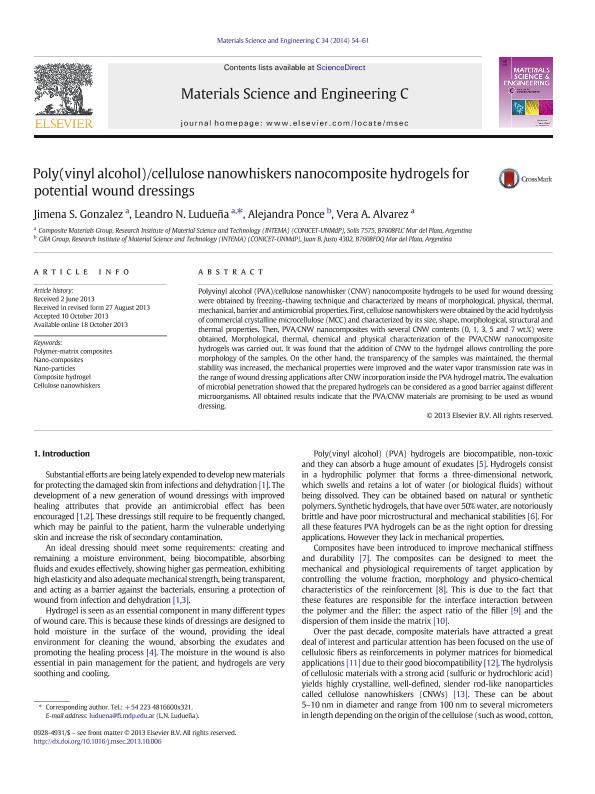Artículo
Poly(vinyl alcohol)/cellulose nanowhiskers nanocomposite hydrogels for potential wound dressings
Gonzalez, Jimena Soledad ; Ludueña, Leandro Nicolás
; Ludueña, Leandro Nicolás ; Ponce, Alejandra Graciela
; Ponce, Alejandra Graciela ; Alvarez, Vera Alejandra
; Alvarez, Vera Alejandra
 ; Ludueña, Leandro Nicolás
; Ludueña, Leandro Nicolás ; Ponce, Alejandra Graciela
; Ponce, Alejandra Graciela ; Alvarez, Vera Alejandra
; Alvarez, Vera Alejandra
Fecha de publicación:
01/2014
Editorial:
Elsevier Science
Revista:
Materials Science and Engineering: C
ISSN:
0928-4931
Idioma:
Inglés
Tipo de recurso:
Artículo publicado
Clasificación temática:
Resumen
Polyvinyl alcohol (PVA)/cellulose nanowhisker (CNW) nanocomposite hydrogels to be used for wound dressing were obtained by freezing–thawing technique and characterized by means of morphological, physical, thermal, mechanical, barrier and antimicrobial properties. First, cellulose nanowhiskers were obtained by the acid hydrolysis of commercial crystalline microcellulose (MCC) and characterized by its size, shape, morphological, structural and thermal properties. Then, PVA/CNW nanocomposites with several CNW contents (0, 1, 3, 5 and 7 wt.%) were obtained. Morphological, thermal, chemical and physical characterization of the PVA/CNW nanocomposite hydrogels was carried out. It was found that the addition of CNW to the hydrogel allows controlling the pore morphology of the samples. On the other hand, the transparency of the samples was maintained, the thermal stability was increased, the mechanical properties were improved and the water vapor transmission rate was in the range of wound dressing applications after CNW incorporation inside the PVA hydrogel matrix. The evaluation of microbial penetration showed that the prepared hydrogels can be considered as a good barrier against different microorganisms. All obtained results indicate that the PVA/CNW materials are promising to be used as wound dressing.
Archivos asociados
Licencia
Identificadores
Colecciones
Articulos(CCT - MAR DEL PLATA)
Articulos de CTRO.CIENTIFICO TECNOL.CONICET - MAR DEL PLATA
Articulos de CTRO.CIENTIFICO TECNOL.CONICET - MAR DEL PLATA
Articulos(INTEMA)
Articulos de INST.DE INV.EN CIENCIA Y TECNOL.MATERIALES (I)
Articulos de INST.DE INV.EN CIENCIA Y TECNOL.MATERIALES (I)
Citación
Gonzalez, Jimena Soledad; Ludueña, Leandro Nicolás; Ponce, Alejandra Graciela; Alvarez, Vera Alejandra; Poly(vinyl alcohol)/cellulose nanowhiskers nanocomposite hydrogels for potential wound dressings; Elsevier Science; Materials Science and Engineering: C; 34; 1-2014; 54-61
Compartir
Altmétricas



